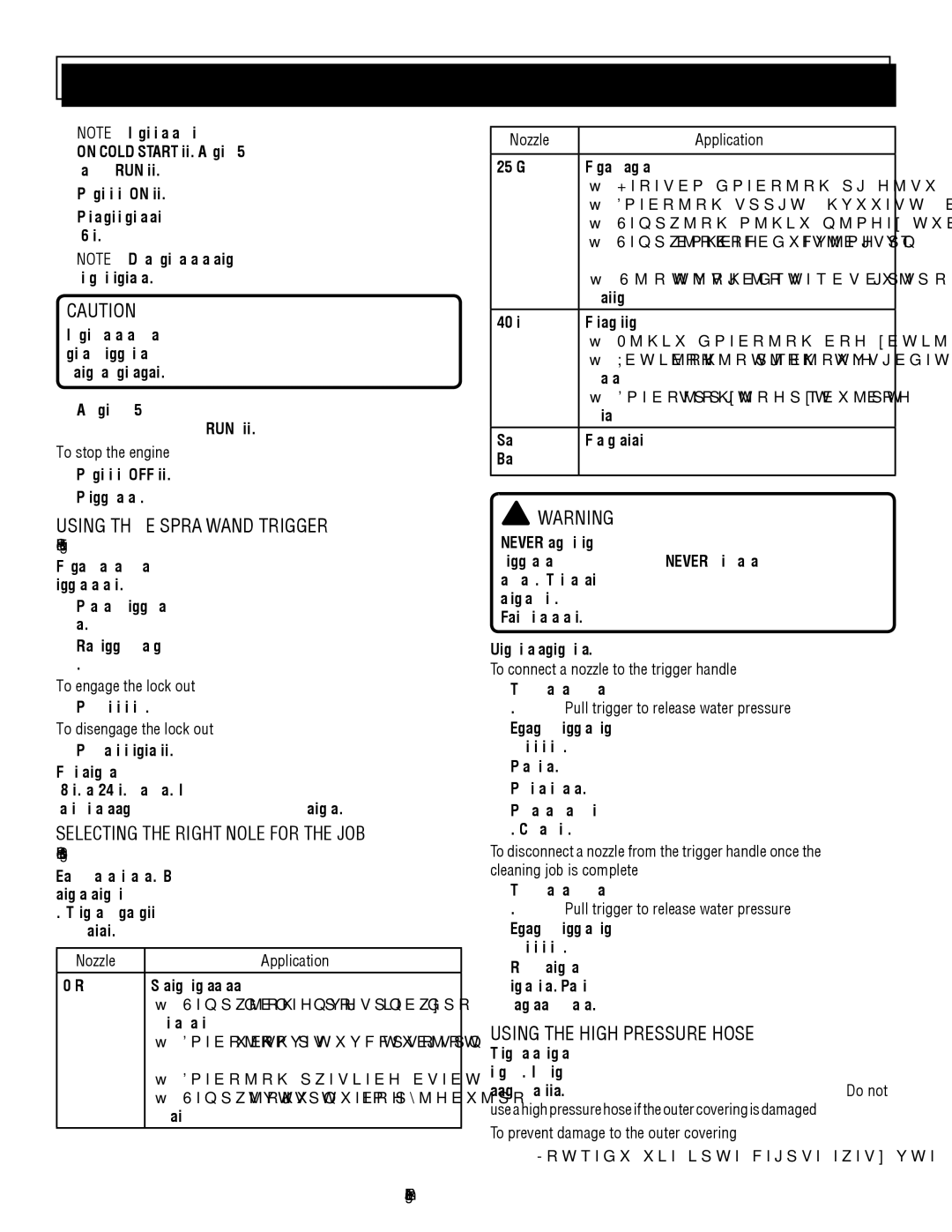
OPERATION
NOTE: If the engine is warm, leave the choke lever in the ON (COLD START) position. Allow the engine to run for 5 seconds, and then push the choke to the RUN position.
nPut the engine switch in the ON position.
nPull the recoil starter grip until the engine runs (a maximum of 6 times).
NOTE: Do not allow the grip to snap back after starting; return it gently to its original place.
CAUTION:
If the engine does not start after each pull of the starter grip and rope, squeeze the trigger to relieve water pres- sure before attempting to start the engine again.
nAllow the engine to run for 5 seconds, then push the choke lever to the RUN position.
To stop the engine:
nPut the engine switch in the OFF position.
nPull trigger to release water pressure.
USING THE SPRAY WAND TRIGGER
See Figure 15.
For greater control and safety, keep both hands on the trigger handle at all times.
nPull back and hold the trigger to operate the pressure washer.
nRelease the trigger to stop the flow of water through the nozzle.
To engage the lock out:
nPush up on the lock out until it clicks into the slot.
To disengage the lock out:
nPush the lock out down and into its original position.
For the most effective cleaning, the spray nozzle should be between 8 in. and 24 in. from the surface to be cleaned. If the spray is too close it can damage the cleaning surface.
SELECTING THE RIGHT NOZZLE FOR THE JOB
See Figures 16.
Each of the nozzles has a different spray pattern. Before starting any cleaning job, determine the best nozzle for the job. The following chart offers some general guidelines to help you choose the best nozzle for your application.
Nozzle | Application |
|
|
0º Red | Spot cleaning of high, |
| • Removing |
| struction, farm, or lawn equipment |
| • Cleaning tar, glue, or stubborn stains from |
| concrete |
| • Cleaning overhead areas |
| • Removing rust from steel and oxidation |
| from aluminum |
|
|
Nozzle | Application |
|
|
25º Green | For general purpose or large surfaces |
| • General cleaning of dirt, mud, and grime |
| • Cleaning roofs, gutters, and downspouts |
| • Removing light mildew stains |
| • Removing algae and bacteria |
| pools |
| • Rinsing surfaces in preparation for |
| painting |
40º White | For |
| • Light cleaning and washing |
| • Washing and rinsing of painted surfaces |
| and boats |
| • Cleaning roofs, windows, patios, and |
| driveways |
|
|
Soap | For all detergent applications |
(Black) |
|
|
|
![]() WARNING:
WARNING:
NEVER change nozzles without locking the lock out on the trigger handle and NEVER point the wand at your face or at others. The
Using the
To connect a nozzle to the trigger handle:
nTurn off the pressure washer and shut off the water supply. Pull trigger to release water pressure.
nEngage the lock out on the trigger handle by pushing up on the lock out until it clicks into the slot.
nPull back the
nPush the nozzle into place in the spray wand.
nPush the collar forward so that the nozzle is secured properly. Check to see that the nozzle is secure.
To disconnect a nozzle from the trigger handle once the cleaning job is complete:
nTurn off the pressure washer and shut off the water supply. Pull trigger to release water pressure.
nEngage the lock out on the trigger handle by pushing up on the lock out until it clicks into the slot.
nRemove the nozzle by placing hand over nozzle then pulling back the
USING THE HIGH PRESSURE HOSE
The high pressure hose features an outer covering that pro- vides strength to the hose. If the outer covering becomes damaged, the hose must be replaced immediately. Do not use a high pressure hose if the outer covering is damaged.
To prevent damage to the outer covering:
nInspect the hose before every use.
